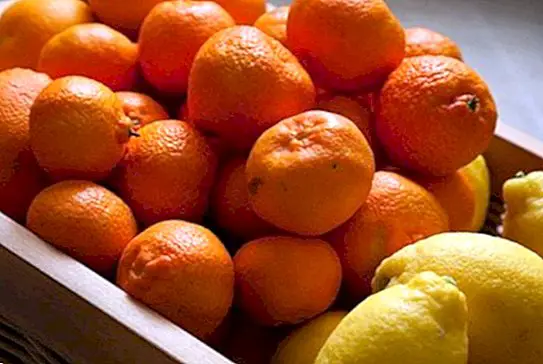Autumn and winter foods: fruits, vegetables and nuts
Every season it has foods specials whose properties, Benefits and actions tend, wisely and naturally, to coincide with the needs of our organization at each time of the year. It is what is known as seasonal foods, and depending ultimately on each season of the year, it is possible to find certain foods (always of natural origin) or others.
For example, in cold seasons such as those we are currently experiencing, and in autumn and winter itself, there are a number of foods that help cope with seasonal changes that tend to harm our body, as with the decrease in sunlight, and the arrival of the cold, it is common for our hormones to be revolutionized, the so-called autumnal asthenia, and also the defenses are weakened.
Luckily, as far as seasonal foods are concerned, we can clearly say that maxim thatnature is wise. Thus, in autumn we can find certain foods (fruits, vegetables and vegetables, nuts), and during the winter months other very different. What offers us not only a wonderful differentiation between seasons, but benefits and nutritional qualities specially focused for the basic characteristics of each season.
What foods can we find in the fall?
Figs
We have already dealt on several occasions about figs. It is perfect and ideal to combat autumnal asthenia, being very rich in vitamins, minerals (among which we find potassium and calcium), proteins and sugars. It also contains antioxidants and helps against inflammation of the tissues.
Grenades
They are rich in minerals and sugars, and have disinfectant, depurative, astringent and detoxifying properties, among others. In addition it also has important antioxidant virtues.
grapes
Although we can find them all year round, and they are also a characteristic food of winter (being a fruit that is usually consumed during the popular New Year's Eve), grapes are a seasonal food whose time begins precisely during the autumn months.
They are very good fruits for circulation, and help to combat aging by containing interesting amounts of free radicals. They are also rich in vitamin C and E, and should not be consumed in excess because of their high sugar content.

Tangerines
Both oranges and tangerines, as we know, are a very important source of vitamin C, a potent antioxidant that, in addition to fighting colds and flu, helps reduce the pain of menstruation rules.
Persimmons
The persimmon is a fruit whose meat stands out precisely for being tasty and delicious. From a nutritional point of view they stand out for their antioxidant and fiber content. Therefore, it is ideal not only against constipation (helps regulate and improve intestinal transit), but to reduce even the risk of arteriosclerosis.
Quince
The quince is a delicious fruit with astringent qualities, acting as an interesting tonic on the intestinal mucous membranes. It also contains mucilage, which is a type of soluble fiber especially useful in case of diarrhea, to retain water and reduce intestinal transit.
Chestnuts
What would be autumn without chestnuts? Raw, roasted or in cakes and biscuits, we are without doubt one of the most characteristic autumnal foods. They are tremendously rich in carbohydrates, which is why they tend to be somewhat caloric. It also provides vitamins and minerals.
Mushrooms and mushrooms
It is also another group of characteristic foods, in the same way that happens with chestnuts. During the autumn, in fact, we can find different delicious varieties (you can read more in the article which mushrooms are edible, how to clean and preserve them), and from a nutritional point of view, they stand out for their content in proteins of high biological value, vitamins , minerals and trace elements.

Pumpkins
It is another highly characteristic food during this time, especially for the popular Halloween Party. Pumpkin is a healthy and healthy vegetable, especially rich in antioxidants, vitamins, minerals (such as magnesium, calcium, phosphorus, potassium and iron), and fiber.
Other seasonal foods
During the autumn it is also possible to find other foods characteristic of this autumnal season. This is the case of certain vegetables such as: carrots, Swiss chard, eggplant, cabbage, sweet potatoes, peppers and spinach.
And in winter? What are the most characteristic foods of the winter season?
Kiwi
Although today it is possible to find it practically all year round in the supermarket, the reality is that the kiwi is also a fruit of the winter season.It stands out for being especially rich in fiber, helping against occasional constipation, in addition, thanks to its content of vitamin C it is a very antioxidant fruit.
Oranges (and tangerines)
While tangerines are customary to begin to find them in the market from the autumn months, oranges are a more characteristic fruit of winter (although it is also another fruit that, nowadays, we can find all year round in the supermarket and in the market). It is especially rich in vitamin C, useful to relieve the symptoms of colds and colds (but not to prevent them), fiber and other antioxidant nutrients.

Avocado
Avocado is a deliciously nutritious fruit, thanks to its richness in vitamin E, A, C and minerals such as potassium. In addition, thanks to its contribution in healthy fats (such as oleic acid), it is ideal to take care of our cardiovascular health.
Images of Istockphoto. This article is published for informational purposes only. You can not and should not replace the consultation with a Nutritionist. We advise you to consult your trusted Nutritionist. ThemesWinter Autumn


